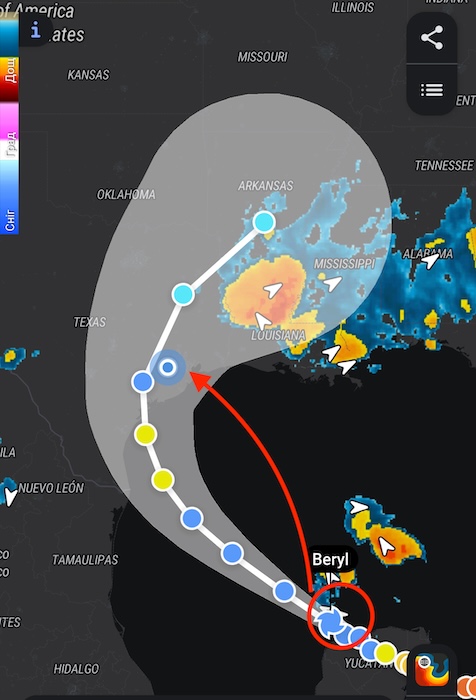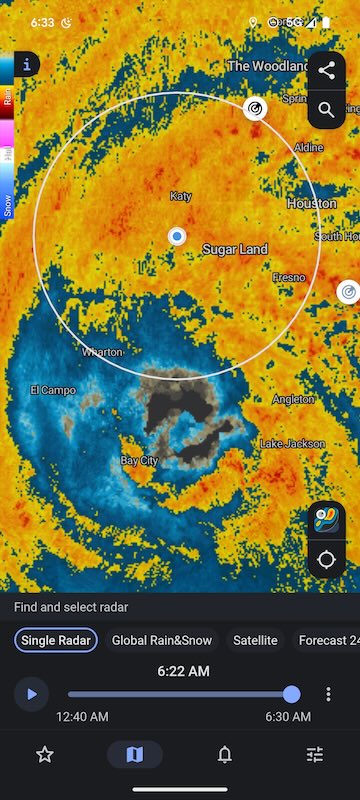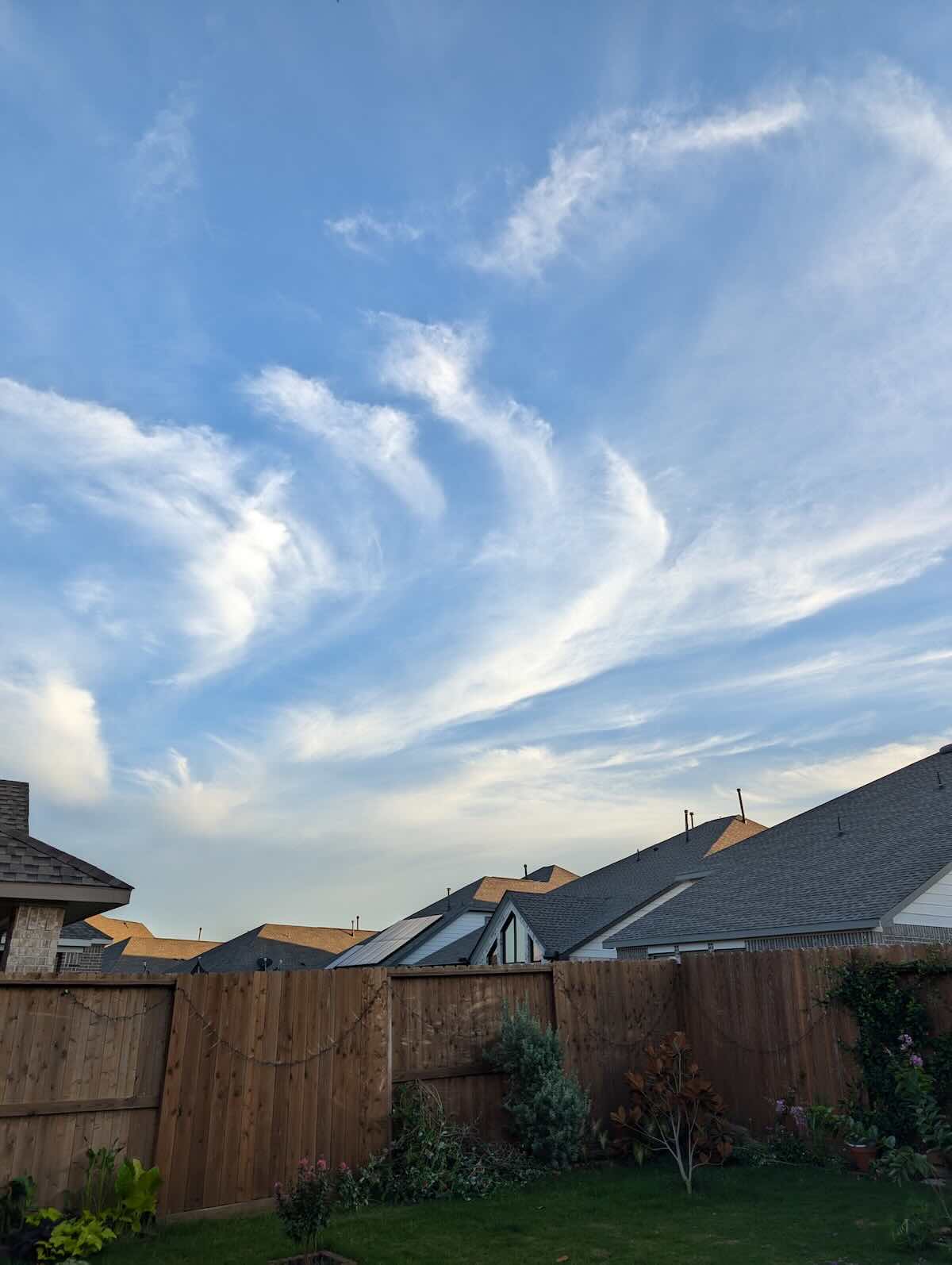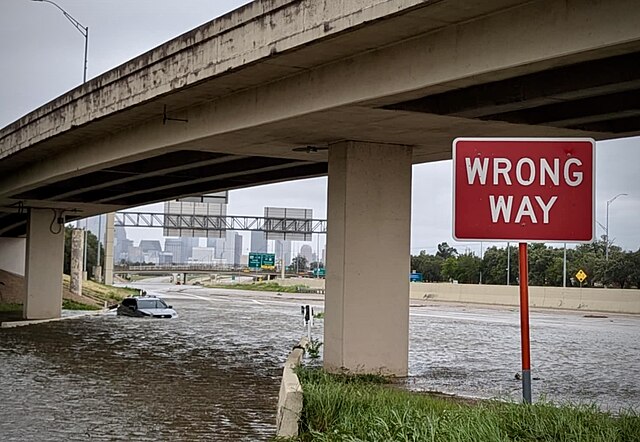On June 28, 2024, a tropical depression formed over the Atlantic and transformed into Hurricane Beryl a day later, marking an explosive start to hurricane season. Beryl was not only the first hurricane in the 2024 season but also the earliest Category 5 Atlantic hurricane of 2024. Such strong tropical cyclones typically occur later in the hurricane season, but Beryl rapidly intensified because of unusually high ocean temperatures. As of August 2024, the tropical cyclone took 64 lives and caused over $6 billion in financial damage.
Oleksii, CEO of RainViewer, happened to be in Beryl’s epicenter while visiting the Texas coast. During his visit, Hurricane Beryl made landfall in Texas near Matagorda, being a Category 1 hurricane at that moment. Here’s a screenshot from the RainViewer hurricane tracker showing the Hurricane Beryl path:
 In this blog post, we will share Oleksii’s first-hand experience as an eyewitness of the Texas hurricane.
In this blog post, we will share Oleksii’s first-hand experience as an eyewitness of the Texas hurricane.
First-Hand Experience: Hurricane Beryl, Texas
In Texas, Hurricane Beryl made a final landfall on July 8, exactly when Oleksii and his family were in the state. Luckily, the hurricane strength was at a minimum (Category 1), but still, it was a frightening experience. The region remained without power after Hurricane Beryl for at least 36 hours while the temperature outside was 100°F (38°C). Some regions, where lots of trees damaged power lines, had no electricity for 5 days. “The TXU Energy app wasn’t working, so we couldn’t figure out which areas were without power. But then, the local burger chain, Whataburger, came to the rescue with a power outage map in their app. People started using it to see if their area had electricity again,” Oleksii said.
Storm Beryl hit the region with strong winds, up to 62 mph (100 km/h), and wind gusts up to 86 mph (140 km/h). “The wind was so strong that the house was shaking, and this nightmare went on for about six hours, from 2 to 8 a.m. We could barely sleep, and it felt like the winds would rip off the roof and the rain would shatter the windows”, Oleksii said.

The hurricane caused severe tree damage in the neighborhood where Oleksii stayed. The house itself survived the storm, but it was shaking to the wind gusts. Two small trees out of four near the house were blown down. In the neighborhood after Hurricane Beryl, many more trees fell, but they were all small because the area was newly built. In other neighborhoods, many trees also fell, but they were bigger. In one of the areas, a huge tree fell on a house and broke it in half, having killed an elderly person.
“At 8:45 a.m. the eye of the storm arrived, and we had some time to rest as the weather became calmer. At 9:30, the mobile Internet disappeared and was back only the next day. At the same time, the wind changed its direction, the gusts became weaker, and the rain started again at 10 a.m. At 2 p.m., after Beryl swept through the area, the sun was shining, as if nothing happened,” Oleksii said.

As Hurricane Beryl slammed into the Gulf Coast near Texas, the authorities were constantly updating people about the hurricane. “We were constantly told on the radio - seek shelter, get to the nearest cooling point… Imagine, there were cooling points for people!” (the ACs didn’t work because of damaged power lines). Locals told Oleksii that power outages are unfortunately common in Texas during natural disasters. For example, a May tornado knocked out power for 6 days in some regions.
Hurricane Beryl’s Consequences for the State of Texas
Surfside Beach experienced severe consequences due to Hurricane Beryl, with one house losing all its siding from the upper level. Over Lake Jackson, the intense winds stripped away roofs, toppled chimneys, and demolished the outer brick layers of buildings.
As Beryl made its way into Texas, Houston experienced the full force of Beryl’s core. Over 2.7 million households lost power. The Houston area was drenched with more than 8 inches (200 mm) of rainfall. The highest recorded amount in the state was 13.55 inches (344 mm).
 Image source: Donald Sparks
Image source: Donald Sparks
In Beaumont, two tornadoes were observed, with the maximum strength reaching EF2.
Fatalities in Texas resulting from Hurricane Beryl were as follows:
- Humble: A 53-year-old man lost his life when an oak tree fell onto his home, trapping him under the wreckage.
- Ponderosa Forest area: A 74-year-old woman died when a tree crashed into her bedroom.
- Southeast Houston: A woman in her fifties was fatally injured in a house fire.
- Houston Avenue: A civilian employee of the Houston Police Department met a tragic end when his vehicle was engulfed by floodwaters.
- New Caney: A man was fatally struck by a tree while operating his tractor.
Conclusion
Hurricane Beryl’s unexpected arrival as the earliest Category 5 hurricane of the Atlantic hurricane season left a lasting impact, marking a catastrophic start to the hurricane season. The storm’s devastating journey from the Atlantic with the landfall on the Texas coast resulted in significant loss of life and property. Oleksii’s first-hand account from the storm’s epicenter underscores the raw power and unpredictability of such natural disasters. It’s crucial to be prepared in the face of hurricanes. Evacuate, because not all houses can stand the hurricane’s power. If you still choose to stay at home, follow these tips:
- Stock up on drinkable and technical water as well as candles, flashlights, batteries, and power banks.
- Stock up on non-perishable food for 5 days, because it may not be easy to prepare food during power outages.
- Fill a full tank of gasoline.
- If possible, buy a power generator and fuel or power banks for it.
- Collect documents, medications, and other things in the case of rapid evacuation.
- Listen to the hurricane warnings and updates on the radio, because there’ll be no Internet.






